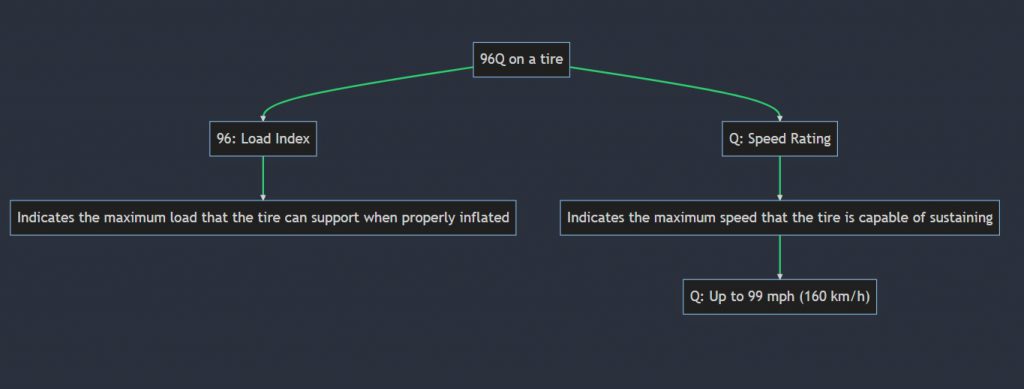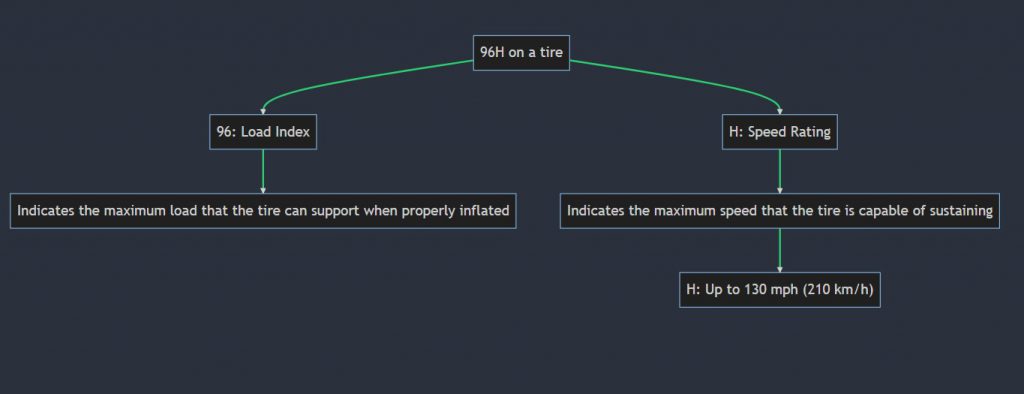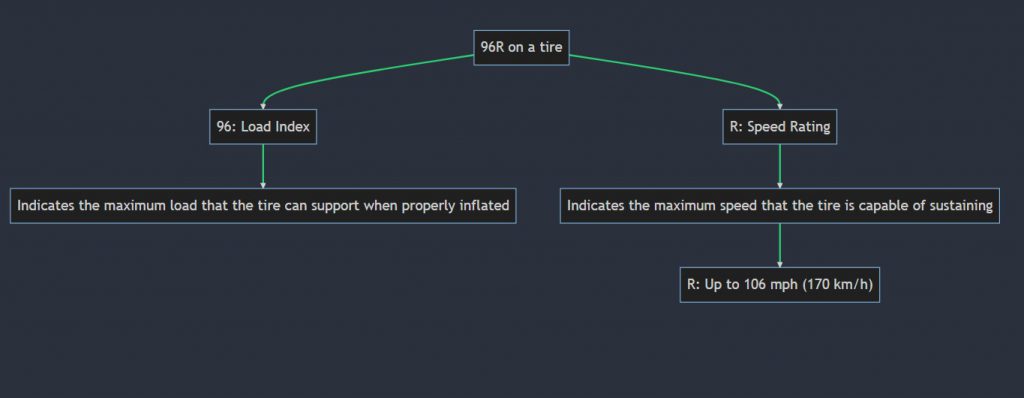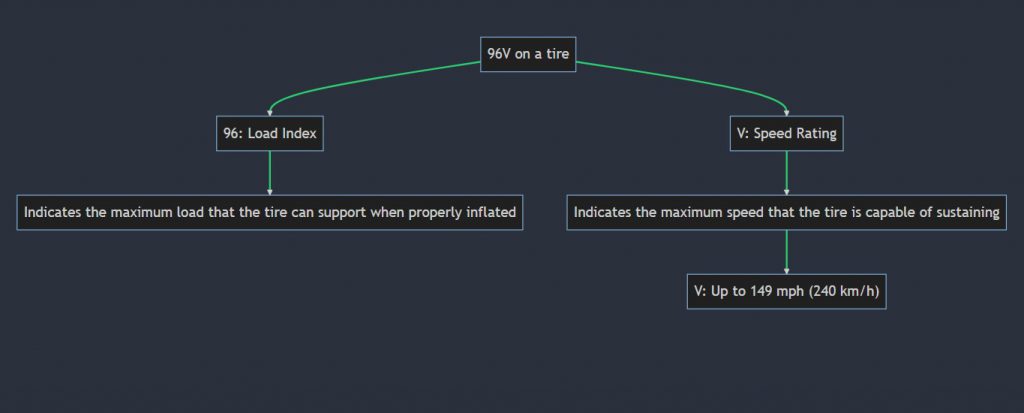Buying a set of tires isn’t just a matter of knowing the size that fits your car, but also understanding the plethora of numbers and letters inscribed on them. They seem like hieroglyphics to the uninitiated, but these mysterious alphanumeric symbols hold crucial information about the tire’s capabilities. To help you decode these mysterious tire symbols, this article focuses on the meanings of 96v, 96h, 96w, 96t, 96y, and similar ratings. Let’s buckle up and venture into this tire-mendous journey! (No apologies for the pun.)
What do 96t, 96s, 96q, 96h, 96r, 96v, 96w mean on a tire?
The numbers and letters (like 96T, 96S, 96Q, 96H, 96R, 96V, 96W) you see on a tire are part of its service description, which encompasses two things: the load index and speed rating. The number part, “96” in these cases, represents the load index, indicating the maximum load the tire can carry at its maximum safe inflation. The letter following the number signifies the tire’s speed rating, that is, the maximum speed at which the tire can carry a load corresponding to its load index.
| Load Index and Speed Rating | Speed Rating Description | Maximum Speed |
| 96V | Very high speed | 149 mph (240 km/h) |
| 96H | High speed | 130 mph (210 km/h) |
| 96T | Touring speed | 118 mph (190 km/h) |
| 96W | Extra high speed | 168 mph (270 km/h) |
| 96Y | Ultra high speed | 186 mph (300 km/h) |
| 96S | Standard speed | 112 mph (180 km/h) |
| 96Q | Special speed rating (typically for light truck tires) | 99 mph (160 km/h) |
Now that we’ve got the gist, let’s delve deeper into the specifics.
What does 96T mean on a tire?
A tire marked 96T signifies a tire that can carry up to 710 kilograms of weight (per tire) at a maximum speed of 190 km/h. The ‘T’ speed rating means it’s designed for vehicles that don’t typically push the speed limit, such as sedans, family minivans, or small SUVs.

Specifics about 96T Tires
96T tires are typically associated with vehicles designed for comfort and efficiency rather than speed. They balance the need for durability, quiet operation, and good tread life.
Typical Use Cases for 96T Tires
96T tires are perfect for moderate speeds and shorter commutes, including urban/suburban driving and highway cruising.
Vehicles Suitable for 96T Tires
96T tires are suitable for:
- Sedans like Honda Accord, Toyota Camry.
- Small SUVs like Hyundai Tucson, Toyota RAV4.
- Minivans like Honda Odyssey, Chrysler Pacifica.
Precautions when Using 96T Tires
Ensure your vehicle’s speed and load do not exceed the tire’s capacity. Regularly check tire pressure and inspect for any signs of wear and tear.
FAQ’s
- Can I use 96T tires for my sports car?
– It’s not recommended as sports cars typically require a higher speed rating.
- Are 96T tires good for all seasons?
– It depends on the specific tire model. Some 96T tires are all-season, while others may be summer or winter specific.
What does 96S mean on a tire?
A 96S tire can carry a maximum load of 710 kilograms and can travel at speeds up to 180 km/h. The ‘S’ rating is common on family sedans and vans.

Specifics about 96S Tires
96S tires prioritize safety, comfort, and longevity. They are not built for speed but offer a smooth ride and good mileage.
Typical Use Cases for 96S Tires
96S tires are ideal for city driving, short to medium distances, and occasional highway use.
Vehicles Suitable for 96S Tires
96S tires can be used on:
- Mid-size sedans such as Ford Fusion, Chevrolet Malibu.
- Small vans like Ford Transit Connect, Mercedes-Benz Metris.
Precautions when Using 96S Tires
Just like any other tire, it’s essential to maintain the correct tire pressure and avoid overloading or overspeeding.
FAQ’s
- Can I replace my 96T tires with 96S?
– It’s generally acceptable as long as the replacement tires meet or exceed the vehicle manufacturer’s load capacity and speed requirement.
- Are 96S tires suitable for snowy conditions?
– Tire performance in snowy conditions depends on whether they are winter tires or not, rather than their load index or speed rating.
What does 96q mean on a tire?
A tire marked as 96Q is designed to carry a maximum load of 710 kilograms and reach top speeds of 160 km/h. Q-rated tires are often found on winter and off-road tires where speed is less important than grip and durability.

Specifics about 96Q Tires
96Q tires are designed to prioritize traction in challenging conditions over high-speed stability. They are built to withstand harsh weather and rough terrains.
Typical Use Cases for 96Q Tires
96Q tires are ideal for off-road adventures and driving in severe winter conditions.
Vehicles Suitable for 96Q Tires
96Q tires are typically used on:
- Off-road vehicles like Jeep Wrangler, Toyota Land Cruiser.
- Pickup trucks like Ford F-150, Chevrolet Silverado.
Precautions when Using 96Q Tires
Make sure to replace them with a higher speed-rated tire for summer or highway driving. Keep in mind that off-road or winter driving can be harsh on tires, so frequent checks are necessary.
FAQ’s
- Can I use 96Q tires all year round?
– It’s not recommended as they may offer less grip in dry conditions and wear more quickly in warmer weather.
- Why is the speed rating lower on 96Q tires?
– The focus with 96Q tires is on providing traction in severe conditions rather than on high-speed driving.
What does 96H mean on a tire?
The “96H” on a tire refers to both its load index and speed rating. The number “96” signifies that the tire has a load index of 96, meaning it can support a maximum load of 710 kg when properly inflated.
The “H” represents the speed rating, indicating that the tire can safely maintain speeds of up to 210 km/h. In a nutshell, a 96H tire is designed to sustain a considerable amount of weight while still capable of maintaining high speeds, often found on sports sedans and coupes.

Specifics about 96H Tires
96H tires blend durability, speed, and comfort. While they can maintain higher speeds, they still prioritize safety and efficient performance.
Typical Use Cases for 96H Tires
96H tires are suitable for highway cruising and longer distance driving due to their higher speed rating.
Vehicles Suitable for 96H Tires
These tires are typically found on:
- Sports sedans like the BMW 3-series or Audi A4.
- Family sedans like Hyundai Sonata or Honda Accord.
Precautions when Using 96H Tires
Always adhere to the speed limit and avoid overloading the tires. Regular inspections for tread wear and maintaining optimal tire pressure are crucial.
FAQ’s
- Are 96H tires suitable for winter driving?
– Whether a tire performs well in winter conditions depends on its design and materials, not its load index or speed rating.
- Can I replace my 96H tires with a different speed rating?
– Yes, but ensure that it meets or exceeds the vehicle’s requirements.
What does 96R mean on a tire?
As it stands, the ‘R’ in tire codes typically stands for ‘Radial’, which pertains to the tire’s construction and not its load or speed capacities. However, if we consider 96R as having ‘R’ represent a speed rating (which is unstandardized), it would indicate a tire that could carry a load of 710 kg and travel up to 170 km/h. For the sake of clarity, we’ll proceed with this unconventional usage.

Specifics about 96R Tires
Though ‘R’ isn’t a recognized speed rating, considering it as such, 96R tires would be built for moderate speeds and typically used for everyday driving.
Typical Use Cases for 96R Tires
96R tires would be ideal for everyday commuting and city driving, as well as occasional highway use.
Vehicles Suitable for 96R Tires
Given the hypothetical nature of 96R tires, they could be suited for:
- Compact cars like Honda Civic or Toyota Corolla.
- Mid-sized sedans like Mazda6 or Ford Fusion.
Precautions when Using 96R Tires
As with any tire, maintain the right tire pressure, and do not exceed the speed and load capacities.
FAQ’s
- Can I use 96R tires for long-distance driving?
– Given their supposed speed rating, they would be better suited for shorter distances or city driving.
- Are 96R tires safe for rainy conditions?
– It would depend on the tire’s design. Look for a tread pattern designed to channel water away from the tire’s contact patch to improve wet traction.
What does 96V mean on a tire?
The term “96V” on a tire indicates the tire’s load index and speed rating. The “96” represents a load index of 96, implying the tire can safely carry a maximum weight of 710 kg when properly inflated. The letter “V” stands for the speed rating, signifying that the tire can maintain speeds up to 240 km/h. Therefore, a 96V tire is a high-performance tire designed to support significant weight while maintaining high speeds, often used in performance and luxury vehicles.

Specifics about 96V Tires
96V tires combine high-speed capabilities with durability and high-load capacity, offering a smooth, controlled ride at high speeds.
Typical Use Cases for 96V Tires
96V tires are ideal for long highway trips and high-speed driving scenarios, such as on a race track.
Vehicles Suitable for 96V Tires
96V tires are often found on:
- High-performance vehicles like the BMW M series, Mercedes-Benz AMG.
- Luxury sedans like the Mercedes-Benz S-Class, BMW 7-series.
Precautions when Using 96V Tires
Ensure that the tires are always properly inflated, regularly inspect for tire damage, and remember that high-speed driving can accelerate tire wear.
FAQ’s
- Are 96V tires suitable for winter driving?
– The tire’s performance in winter conditions relies more on its design and materials than its speed rating.
- Can I use 96V tires for off-road driving?
– These tires are usually designed for highway and track use, and may not perform well off-road.
What does 96W mean on a tire?
A “96W” tire carries a load index of 96, indicating it can safely support a load of 710 kg. The “W” is the speed rating, signifying this tire can maintain speeds up to 270 km/h. Hence, a 96W tire is a very high-performance tire, able to handle substantial weight while still providing exceptional speed performance.

Specifics about 96W Tires
96W tires are designed for high-speed stability, traction, and handling, while still being capable of supporting a significant load.
Typical Use Cases for 96W Tires
96W tires are suitable for high-speed highway cruising, track driving, and sporty driving styles.
Vehicles Suitable for 96W Tires
You will typically find 96W tires on:
- High-performance sports cars like Porsche 911, Chevrolet Corvette.
- High-performance luxury sedans like the Audi RS series, Mercedes-AMG GT series.
Precautions when Using 96W Tires
Maintain proper tire pressure, check regularly for damage or excessive wear, and remember that high-speed driving can lead to accelerated tire wear.
FAQ’s
- Can I replace my 96V tires with 96W tires?
– Yes, as long as it meets or exceeds the vehicle’s requirements.
- Are 96W tires suitable for winter conditions?
– Performance in winter conditions depends on the tire’s design and materials, not its speed rating.
Recap And Summary
Let’s take a step back and sum up what we’ve learned. Tires marked with codes like 96V, 96H, 96W, 96T, 96Y, 96S, and 96Q are referring to the load index and speed rating of the tire. The number (96 in these examples) is a load index that represents the maximum weight the tire can safely support when properly inflated, and the letter signifies the speed rating, indicating the maximum speed the tire can safely maintain.
From sporty 96V and 96W tires suitable for high-performance vehicles, to the sturdy 96T tires for regular passenger cars, and the load-bearing 96Q tires for light trucks and SUVs, each of these tires serves a specific purpose. These ratings aren’t random, but carefully determined by the tire manufacturers based on rigorous testing to ensure that they can perform safely under the weight and speed they’re rated for.
Why is it important to know the load index and speed rating of a tire?
Knowledge of the load index and speed rating of a tire is crucial for a myriad of reasons. Here’s why:
- Safety: The load index and speed rating ensure that your tires can safely support the weight of your vehicle and achieve the speeds you need. Using tires with an incorrect load index could lead to tire failure, and using tires with a lower speed rating than necessary can lead to heat buildup and potential blowouts.
- Performance: Different vehicles and driving styles require different performance levels from their tires. A high-performance car needs tires with a high speed rating to deliver its full potential, while a heavy SUV needs tires with a high load index to support its weight safely. Understanding these ratings ensures you’re getting the performance you need from your tires.
- Legal Requirements: In some jurisdictions, it is a legal requirement to have tires that meet the manufacturer’s specified load index and speed rating. Failure to meet these requirements can result in penalties and may invalidate your insurance.
- Efficiency: Correctly loaded and inflated tires contribute significantly to fuel efficiency. Overloaded or underinflated tires increase rolling resistance and, consequently, fuel consumption.
- Cost: Choosing the right tire can also impact the cost. Tires with higher speed ratings, while offering better performance, usually cost more and wear faster than lower speed-rated tires.
In a nutshell, understanding the load index and speed rating of a tire is about safety, performance, legality, and economy. These ratings ensure you get the right tire for your vehicle and driving needs, reducing risks and potentially saving you time and money in the long run. So next time you’re in the market for new tires, you’ll know what those numbers and letters mean and make an informed decision like a pro!
FAQs
- What does 96W XL mean on a tire?
The “XL” in 96W XL stands for “Extra Load.” This indicates that the tire is designed to carry more weight than a standard tire of the same size. The “96W” part still stands for the same load index and speed rating as discussed earlier.
- What does 96V XL mean on a tire?
Just like with 96W XL, the “XL” in 96V XL indicates that the tire has an extra load capacity compared to standard tires of the same size. “96V” denotes a load index of 96 and a speed rating of V.
- 96V vs 96W: What’s the difference?
The main difference between 96V and 96W is the speed rating. The ‘V’ rated tire is designed to handle speeds up to 240 km/h, while the ‘W’ rated tire can handle speeds up to 270 km/h.
- 96V vs 96H: What’s the difference?
Again, the difference lies in the speed rating. A 96H tire is rated for speeds up to 210 km/h, while a 96V tire can handle speeds up to 240 km/h.
- 96V vs 96Y: What’s the difference?
In this case, a 96V tire can sustain speeds up to 240 km/h, whereas a 96Y tire can maintain speeds up to 300 km/h. 96Y tires are typically found on supercars and high-performance sports cars.
- 96W vs 96Y: What’s the difference?
A 96W tire can handle speeds up to 270 km/h, while a 96Y tire can perform at speeds up to 300 km/h. These tires are typically used on different types of high-performance vehicles.
Final Verdict
Knowing what the numbers and letters mean on your tire is more than just a cool party trick—it’s a critical part of being a responsible driver. By understanding your vehicle’s requirements and matching them to the appropriate load index and speed rating, you ensure the safety and efficiency of your driving experience.
Moreover, it’s essential to bear in mind that these ratings are the maximum limits under ideal conditions. So, just because your tire can technically handle a certain speed doesn’t mean it’s safe or legal to drive at those speeds—always follow local traffic regulations and drive responsibly.
In conclusion, no matter if your journeys take you to the supermarket, across the country, or even the racetrack, understanding your tires is a crucial part of the trip. So remember, whether it’s a 96V or a 96W, your tires are more than just rubber on the road—they’re the foundation of every journey. Happy driving!
Alternative Tire Size Codes of Similar Specifications

AR Jeet has been a tire mechanic for over 2years. He has worked on all types of vehicles, from cars and trucks to RVs and ATVs and motorcycles. He has seen it all when it comes to tires, and he knows how to fix them.
AR Jeet is a tire expert, and he is passionate about his work. He loves to help people keep their vehicles running smoothly, and he is always happy to answer any questions that people have about their tires.
If you need help with your tires, or if you just want to learn more about them, then AR Jeet is the man to talk to. He will be happy to help you out, and he will make sure that you get the best possible solution.
He has a blog [Tirespick.com] where he writes about all things tire-related, and he is always happy to help people with their tire needs. Know more about AR Jeet.
